In aviation, a go-around is an aborted landing of an aircraft that is on final approach or has already touched down. A go-around can either be initiated by the pilot flying or requested by air traffic control for various reasons, such as an unstabilized approach or an obstruction on the runway. Go arounds are also referred to as overshoots in some cases, a name also given to running off the end of the runway.

Cruise is the phase of aircraft flight that starts when the aircraft levels off after a climb, until it begins to descend for landing. Cruising usually comprises the majority of a flight, and may include changes in heading, airspeed, and altitude.
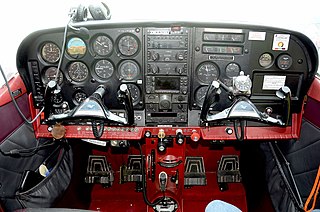
Aircraft engine controls provide a means for the pilot to control and monitor the operation of the aircraft's powerplant. This article describes controls used with a basic internal-combustion engine driving a propeller. Some optional or more advanced configurations are described at the end of the article. Jet turbine engines use different operating principles and have their own sets of controls and sensors.
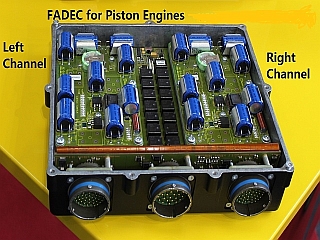
A full authority digital engine (or electronics) control (FADEC) is a system consisting of a digital computer, called an "electronic engine controller" (EEC) or "engine control unit" (ECU), and its related accessories that control all aspects of aircraft engine performance. FADECs have been produced for both piston engines and jet engines.
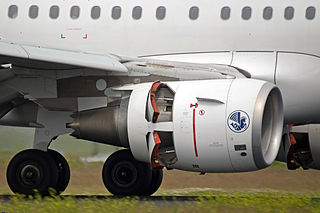
Thrust reversal, also called reverse thrust, is the temporary diversion of an aircraft engine's thrust for it to act against the forward travel of the aircraft, providing deceleration. Thrust reverser systems are featured on many jet aircraft to help slow down just after touch-down, reducing wear on the brakes and enabling shorter landing distances. Such devices affect the aircraft significantly and are considered important for safe operations by airlines. There have been accidents involving thrust reversal systems, including fatal ones.

Scandinavian Airlines System Flight 751 was a regularly scheduled Scandinavian Airlines passenger flight from Stockholm, Sweden, to Warsaw, Poland, via Copenhagen, Denmark. On 27 December 1991, a McDonnell Douglas MD-81 operating the flight, registration OY-KHO, piloted by Danish Captain Stefan G. Rasmussen (44); and Swedish first officer Ulf Cedermark (34), both experienced pilots with 8,000 and 3,000 flight hours, respectively, was forced to make an emergency landing in a field near Gottröra, Sweden. Ice had collected on the wings' inner roots before takeoff, broke off, and was ingested into the engines as the aircraft became airborne on takeoff, ultimately resulting in the failure of both engines. All 129 passengers and crew aboard survived.

A compressor stall is a local disruption of the airflow in the compressor of a gas turbine or turbocharger. A stall that results in the complete disruption of the airflow through the compressor is referred to as a compressor surge. The severity of the phenomenon ranges from a momentary power drop barely registered by the engine instruments to a complete loss of compression in case of a surge, requiring adjustments in the fuel flow to recover normal operation.
A flight management system (FMS) is a fundamental component of a modern airliner's avionics. An FMS is a specialized computer system that automates a wide variety of in-flight tasks, reducing the workload on the flight crew to the point that modern civilian aircraft no longer carry flight engineers or navigators. A primary function is in-flight management of the flight plan. Using various sensors (such as GPS and INS often backed up by radio navigation) to determine the aircraft's position, the FMS can guide the aircraft along the flight plan. From the cockpit, the FMS is normally controlled through a Control Display Unit (CDU) which incorporates a small screen and keyboard or touchscreen. The FMS sends the flight plan for display to the Electronic Flight Instrument System (EFIS), Navigation Display (ND), or Multifunction Display (MFD). The FMS can be summarised as being a dual system consisting of the Flight Management Computer (FMC), CDU and a cross talk bus.
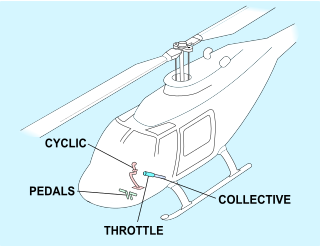
A helicopter pilot manipulates the helicopter flight controls to achieve and maintain controlled aerodynamic flight. Changes to the aircraft flight control system transmit mechanically to the rotor, producing aerodynamic effects on the rotor blades that make the helicopter move in a deliberate way. To tilt forward and back (pitch) or sideways (roll) requires that the controls alter the angle of attack of the main rotor blades cyclically during rotation, creating differing amounts of lift (force) at different points in the cycle. To increase or decrease overall lift requires that the controls alter the angle of attack for all blades collectively by equal amounts at the same time, resulting in ascent, descent, acceleration and deceleration.

TAROM Flight 371 was a scheduled international passenger flight, with an Airbus A310 from Otopeni International Airport in Romania's capital Bucharest to Brussels Airport in Brussels, Belgium. The flight was operated by TAROM, the flag carrier of Romania. On 31 March 1995, the Airbus A310-324, registered as YR-LCC, entered a nose-down dive after takeoff and crashed near Balotești in Romania. All 60 people aboard were killed in the crash.
An autobrake is a type of automatic wheel-based hydraulic brake system for advanced airplanes. The autobrake is normally enabled during takeoff and landing procedures, when the aircraft's longitudinal deceleration system can be handled by the automated systems of the aircraft itself in order to keep the pilot free to perform other tasks.
A takeoff/go-around switch is a switch on the autothrottle of modern large aircraft, with two modes: takeoff (TO) and go-around (GA). The mode is dependent on the phase of flight; usually, on approach to land, the autopilot will be set to approach mode, therefore if the TO/GA switch is pressed it will activate the go-around mode of the autothrottle (about 90-92% N1, if pressed again, go around thrust will increase to full ; conversely, when takeoff is set on the autopilot, the switch activates takeoff mode of the autothrottle. On Boeing aircraft TO/GA modes are selected by a separate button near the throttle levers, but on Airbus aircraft it is activated by advancing the thrust levers forward to the TO/GA detent.

TAM Transportes Aéreos Regionais Flight 402 was a scheduled domestic flight from São Paulo–Congonhas International Airport in São Paulo, Brazil to Recife International Airport in Recife via Santos Dumont Airport in Rio de Janeiro. On 31 October 1996, at 8:27 (UTC-2), the starboard engine of the Fokker 100 operating the route reversed thrust while the aircraft was climbing away from the runway at Congonhas. The aircraft stalled and rolled beyond control to the right, then struck two buildings and crashed into several houses in a heavily populated area only 25 seconds after takeoff. All 95 people on board were killed, as well as another 4 on the ground. It is the fourth deadliest accident in Brazilian aviation history, the second at the time. It is also the deadliest aviation accident involving a Fokker 100.

The Short SC.1 was the first British fixed-wing vertical take-off and landing (VTOL) jet aircraft. It was developed by Short Brothers. It was powered by an arrangement of five Rolls-Royce RB.108 turbojets, four of which were used for vertical flight and one for conventional horizontal flight. The SC.1 had the distinction of being the first British fixed-wing VTOL aircraft and the first one to transition between vertical and horizontal flight modes; it was also the first VTOL-capable aircraft with a fly-by-wire control system.
Landing High Japan (ランディングハイジャパン) is an arcade video game in which the object is to pilot a commercial airliner, taking off from and landing at several Japanese airports. It is a part of the Landing series of airline simulation arcade games which also includes Midnight Landing (1987), Top Landing (1988) and Landing Gear (1995).

Turkish Airlines Flight 1951 was a passenger flight that crashed during landing at Amsterdam Schiphol Airport, the Netherlands, on 25 February 2009, resulting in the deaths of nine passengers and crew, including all three pilots.
Several aviation incidents and accidents have occurred in which the control surfaces of an aircraft became disabled, often due to failure of hydraulic systems or the flight control system. Other incidents have occurred where controls were not functioning correctly prior to take-off, either due to maintenance or pilot error, and controls can become inoperative from extreme weather conditions. Aircraft are not designed to be flown in such circumstances; however, a small number of pilots have had some success in flying and landing aircraft with disabled controls.

On April 4, 1955, a United Airlines Douglas DC-6 named Mainliner Idaho crashed shortly after taking off from Long Island MacArthur Airport, in Ronkonkoma, Islip, New York, United States.

Bhoja Air Flight 213 was a domestic scheduled passenger flight operated by Pakistani airline Bhoja Air from Karachi to Islamabad. On 20 April 2012, the Boeing 737-236A aircraft serving the route crashed in bad weather during its final approach to land. All 121 passengers and 6 crew members aboard were killed. With 127 deaths, it remains as the second deadliest air disaster in Pakistan.
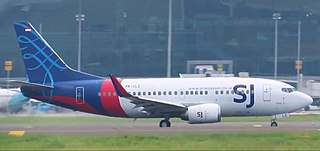
Sriwijaya Air Flight 182 was a scheduled domestic passenger flight from Jakarta to Pontianak, Indonesia. Five minutes after departing from Soekarno–Hatta International Airport on 9 January 2021, the Boeing 737-500 experienced an upset and crashed into the Java Sea off the Thousand Islands, killing all 62 people on board. A search of the area recovered wreckage, human remains, and items of clothing. The flight data recorder (FDR) was recovered on 12 January, and the data storage module of the cockpit voice recorder was recovered on 30 March.














